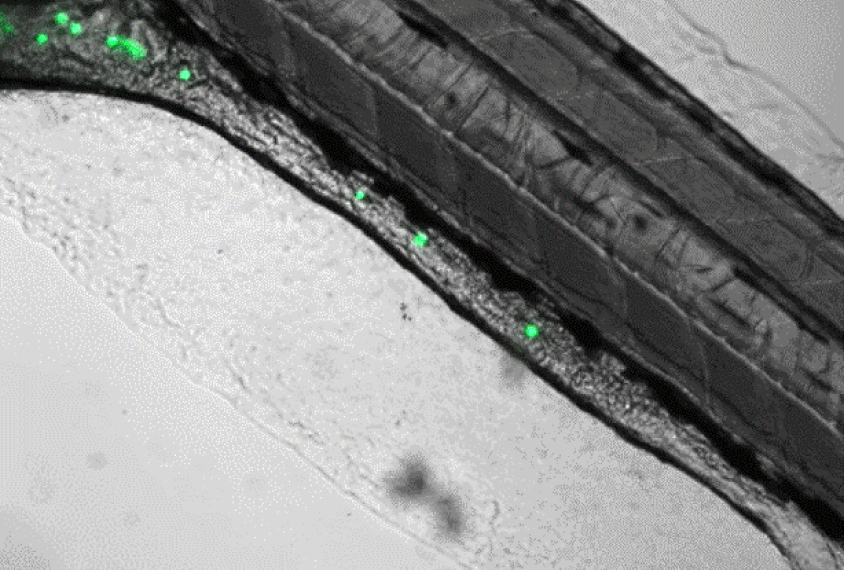Editor’s Note
This article was originally published on 20 November, based on preliminary data presented at a conference. We have updated the article to include additional outside comments from researchers.

Mutations in a top autism gene called SYNGAP1 slow the rate at which zebrafish digest food and pass waste, and may also disrupt gut function in people.
This article was originally published on 20 November, based on preliminary data presented at a conference. We have updated the article to include additional outside comments from researchers.
Mutations in a top autism gene called SYNGAP1 slow the rate at which zebrafish digest food and pass waste. The findings may explain why some people with SYNGAP1 mutations have gastrointestinal (GI) problems.
Researchers presented the unpublished work on 17 and 18 November at the 2020 International SYNGAP1 Scientific Conference, which took place virtually because of the coronavirus pandemic. They also began recruiting people with SYNGAP1 mutations at the meeting for an ongoing study of gut function.
“It’s been in the literature, this link between GI symptoms and [autism], for a long time, with not a lot of progress on the mechanisms,” says lead researcher Julia Dallman, associate professor of biology at the University of Miami in Florida, who presented the findings on 18 November.
In the brain, SYNGAP1 functions mainly at synapses, or the junctions between neurons, and helps the cells exchange chemical messages. Mutations in the gene are strongly linked to autism, seizures, intellectual disability and sleep problems.
Prompted by families’ anecdotal reports of constipation, reflux and overeating in people with SYNGAP1 mutations, Dallman and her colleagues decided to explore the gene’s role in the gut.
“When people think constipation, they think, ‘Oh yeah, that’s a nuisance,’” says Shilpa Kadam, associate professor of neurology at the Kennedy Krieger Institute in Baltimore, Maryland, who was not involved in the work. “But this is constipation that you would have to take the child to the clinic to have the bowels cleared out because they’re not moving at all.”
It’s important that Dallman’s lab is looking at the role of SYNGAP1 in the gut, Kadam says. “You cannot just focus on what it’s doing at the synapse.”
The young zebrafish’s transparent skin allowed the researchers to trace the movement of microscopic fluorescent beads — mixed into the fish’s food — through the gut. In this way, they measured how quickly and how strongly the digestive tract moves food and waste.
Zebrafish with a mutated copy of SYNGAP1 have significantly weaker peristalsis — the rhythmic contractions that move food and waste through the gut — than do fish with intact copies of the gene, the researchers found.
The result jibes with the team’s 2019 study of fish with a mutated copy of SHANK3, another top autism gene. Those fish, too, showed weaker peristaltic action than the wildtype fish, and even slower peristalsis than the SYNGAP1 fish.
It’s too early to tell how the zebrafish findings relate to the digestive issues seen in people, researchers say, but they have some ideas.
A specific type of cell, called an enteroendocrine cell, in the digestive tract is significantly altered in SYNGAP1 and SHANK3 mutant zebrafish compared with those in the wildtype fish. These cells sense chemicals and how far the gut is stretching, and send messages to the enteric nervous system about what and how much is moving through. The enteric nervous system, in turn, sends these messages to the brain.
Cell staining revealed low serotonin expression in the enteroendocrine cells in the mutant fish’s guts compared with wildtype fish. Due to this dearth, they may not accurately sense the gut’s contents, such that the brain and intestines cannot respond appropriately with contractions.
“There’s a direct connection between these cells that are sensing what’s in the gut, and the communication line between the gut and the brain,” says David James, a doctoral student in Dallman’s lab who presented the zebrafish work on 17 November. “We’re thinking that those mutations are impacting the enteroendocrine cells’ ability to communicate with the enteric nervous system and with the brain at large. Like much of autism, this basically breaks down to a cell-to-cell communication issue.”
Most work on SYNGAP1’s function has involved mice, so the fact that this research used zebrafish is important, says James Clement, assistant professor of neuroscience at the Jawaharlal Nehru Centre for Advanced Scientific Research in Bangalore, India, who was not involved in the work.
“It will help to progress the understanding of what is happening in SYNGAP1 mutation, using an entirely different animal model,” he says.
Tracking digestion in people typically involves X-ray imaging, but that approach would be difficult for children with SYNGAP1 mutations, who are often hyperactive and might not be able to lie still long enough. So, inspired by the zebrafish results, Dallman’s team took a different tack: blue ‘Smurf cakes,’ named after the cartoon characters of the same hue.
“You eat angel-food cake with blue dye in it, after a fast, and then measure the time until the blue poop arrives,” Dallman says. Because the digestive system does not break down the dye, the Smurf cakes give researchers an accurate measurement of how long it takes the children to digest and excrete the blue-dyed food.
“It’s objective. You’re not asking parents to interpret it,” Dallman says.
They have not yet published results from the Smurf cake trials, but the tracer seems to work, Dallman says, and they have validated the measurement technique against an existing X-ray observation technique.
Her team is also developing a mobile phone app that parents can use to collect observations on their children’s bowel movements and signs of GI distress — and to tell researchers which new questions they should be asking. The researchers plan to use these observations to inform and refine further studies on zebrafish.
Read more reports from the 2020 International SYNGAP1 Scientific Conference.



